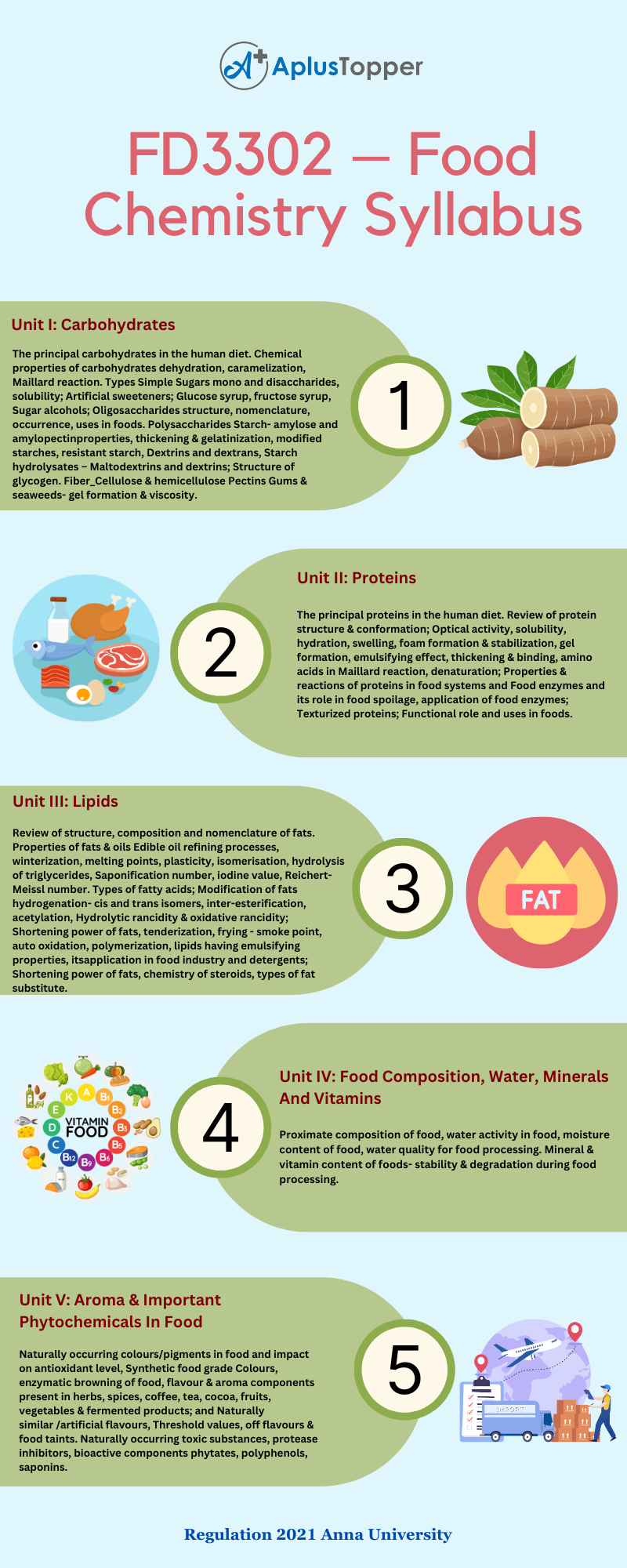FD3302 Subject code belongs to the Anna University, B.Tech Food Technology Semester III syllabus. In this article, we discuss the syllabus of the Food Chemistry subject. We hope it helps the students prepare for the academic exams.
The following article, FD3302 – Food Chemistry Syllabus assists the students in thorough preparation for theory examinations. We include the detailed syllabus along with the expertise referred textbooks and references. Students can easily get information regarding the Food Chemistry syllabus, we add every concept to each unit. You can follow the information and prepare well if you have any doubts regarding the syllabus of this subject. You can comment below. Aplustopper.com will be available as soon as possible. Hope this information is useful. Don’t forget to share this information with your classmates.
If you want to know more about the syllabus of B.Tech Biotechnology and Biochemical Engineering Syllabus connected to an affiliated institution’s four-year undergraduate degree program. We provide you with a detailed Year-wise, semester-wise, and Subject-wise syllabus in the following link B.Tech Food Technology Syllabus Anna University, Regulation 2021.
Aim of Objectives:
The course aims to enable the students to
- develop the knowledge in the basic area of Food Chemistry such as the composition and properties of food and the chemical changes of nutrients during handling, processing, and storage.
- effectively understand food processing and technology.
- appreciate the similarities and complexities of the chemical components in foods.
FD3302 – Food Chemistry Syllabus
Unit I: Carbohydrates
The principal carbohydrates in the human diet. Chemical properties of carbohydrates dehydration, caramelization, Maillard reaction. Types Simple Sugars mono and disaccharides, solubility; Artificial sweeteners; Glucose syrup, fructose syrup, Sugar alcohols; Oligosaccharides structure,
nomenclature, occurrence, uses in foods. Polysaccharides Starch- amylose and amylopectin properties, thickening & gelatinization, modified starches, resistant starch, Dextrins and dextrans, Starch hydrolysates – Maltodextrins and dextrins; Structure of glycogen. Fiber_Cellulose & hemicellulose Pectins Gums & seaweeds- gel formation & viscosity.
Unit II: Proteins
The principal proteins in the human diet. Review of protein structure & conformation; Optical activity, solubility, hydration, swelling, foam formation & stabilization, gel formation, emulsifying effect, thickening & binding, amino acids in Maillard reaction, denaturation; Properties & reactions of proteins in food systems and Food enzymes and its role in food spoilage, application of food enzymes; Texturized proteins; Functional role and uses in foods.

Unit III: Lipids
Review of structure, composition and nomenclature of fats. Properties of fats & oils Edible oil refining processes, winterization, melting points, plasticity, isomerisation, hydrolysis of triglycerides, Saponification number, iodine value, Reichert-Meissl number. Types of fatty acids; Modification of fats hydrogenation- cis and trans isomers, inter-esterification, acetylation, Hydrolytic rancidity & oxidative rancidity; Shortening power of fats, tenderization, frying – smoke point, auto oxidation, polymerization, lipids having emulsifying properties, its application in food industry and detergents; Shortening power of fats, chemistry of steroids, types of fat substitute.
Unit IV: Food Composition, Water, Minerals And Vitamins
Proximate composition of food, water activity in food, moisture content of food, water quality for food processing. Mineral & vitamin content of foods- stability & degradation during food processing.
Unit V: Aroma & Important Phytochemicals In Food
Naturally occurring colours/pigments in food and impact on antioxidant level, Synthetic food grade Colours, enzymatic browning of food, flavour & aroma components present in herbs, spices, coffee, tea, cocoa, fruits, vegetables & fermented products; and Naturally similar /artificial flavours, Threshold values, off flavours & food taints. Naturally occurring toxic substances, protease inhibitors, bioactive components phytates, polyphenols, saponins.
Text Books:
- Belitz H.-D, Grosch W and Schieberle P. Food Chemistry, 4th Edition, Springer-Verlag, 2009.
- Meyer, Lillian Hoagland “Food Chemistry”. CBS Publishers, 1987.
- John M. de Man. “Principles of Food Chemistry”. 3rd Edition, Springer, 1999.
- Chopra, H.K. and P.S. Panesar. “Food Chemistry”. Alpha Science International Limited,2010
References:
- Vaclavik, V. A. and Christian E. W. “Essentials of Food Science”. 4th Edition, Kluwer_Academic, Springer, 2014.
- Richard Owusu-Apenten “Introduction to Food Chemistry” CRC Press, 2005.
- Srinivasan Damodaran, Kirk L. Parkin, “ Fennema’s Food Chemistry “ 5th Edition, CRCPress, 2008.
Related Posts On Semester – III:
Must Read:
